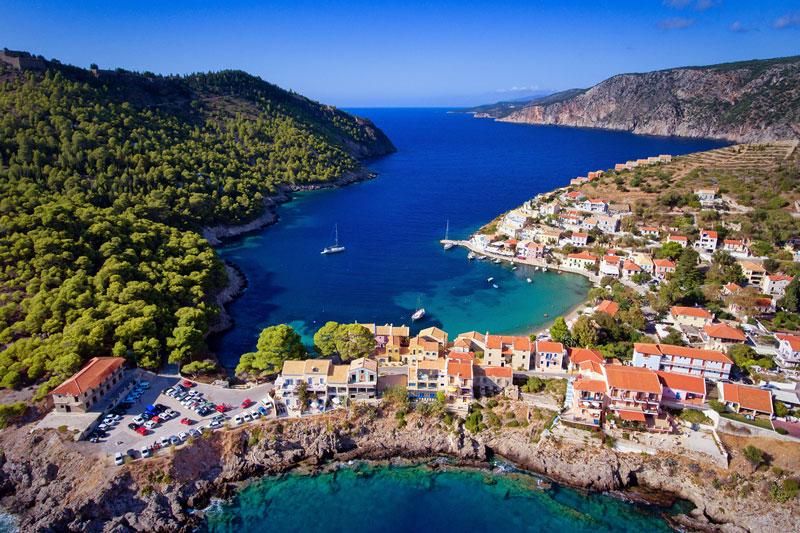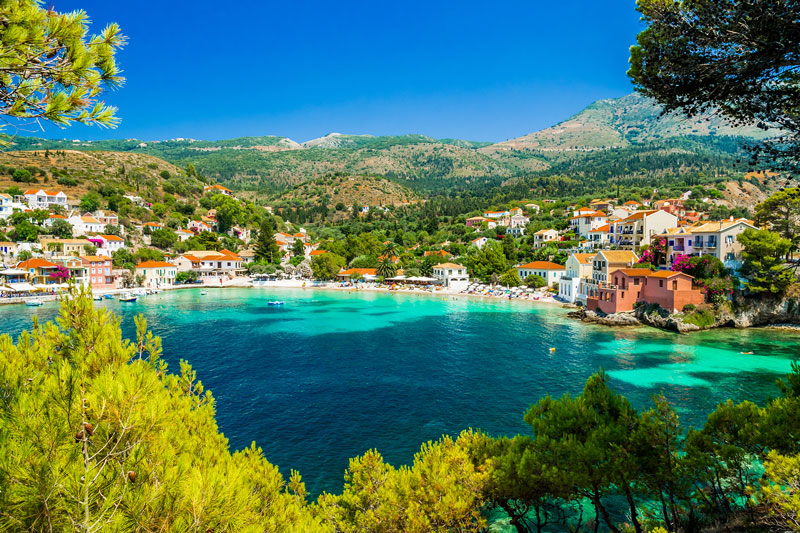For any traveller whose impression of the Greek Islands has been gained from the Aegean, the first sight of the much lusher Ionian Islands can be quite a surprise.
This group of seven islands which stretches down the west coast of Greece from Kérkyra (better known as Corfu) to Kýthira (hardly known at all) experiences heavier rainfall, to the benefit of the olive groves, vineyards and orchards. Corfu gained a reputation as an island ruined by tourism, descended on annually by European youth out for a good time. While the island still attracts some such visitors, it is also a place where you can find traditional Greek hospitality, quiet villages and beautiful beaches.
Paxoí to the south is a tiny olive filled island of just three villages. The southernmost island of Kythira is closer to Crete than to its Ionian neighbours, and perhaps also closer to the true Greek spirit.
Itinerary – Kefalonia & The Ionian

Day 1 – Lefkas
Despite being connected to the mainland by a narrow causeway, making it one of the few Greek islands that you can drive to, much of Lefkas remains surprisingly unaffected by tourism. Laid-back Lefkas Town is a charming place to spend a day, while the soaring mountains of the interior still conceal timeless villages and wild olive groves, and the rugged west coast holds some amazing beaches. Only along the east coast are there some overdeveloped enclaves; if you continue all the way south, you’ll find stunning little bays and inlets, as well as windy conditions that attract kite and windsurfers from all over the world. Lefkada was originally a peninsula, not a true island. Corinthian colonisers cut a canal through the narrow isthmus that joined it to the rest of Greece in the 8th century BC.
Day 2 – Meganisi
Meganisi is a stunning green little island located between Lefkas and the western coast of the Greek mainland. Untouched by mass tourism it boasts an unspoiled beauty, perfect for relaxing in tranquility. Vathy is the main port and the quaintest village of Meganisi. Spend a day strolling around the beach promenade, taste local specialties at one of the fish taverns – and relax!


Day 3 – Kalamos
Wander around in the narrow streets, talk to the locals about the old times and life on the island. Walk from Kalamos to Episkopi through untouched, authentic landscape and redefine the values of life. From Kalamos visit by bike the southern end of the island, the abandoned settlement at Head. Old mills, stone threshing, dilapidated houses, half ruined windmills that are still standing, as if the time stopped suddenly. All there, silent witnesses of a bygone era.
Day 4 – Ithaca
Home of Ulysses, the legendary hero of Homer, this tiny island attracts visitors from around the world. This lush green island is surrounded by crystal water and has wonderful coves around its coastline. Because of its small size, it is not as touristic as the neighbouring islands, being a place for total relaxation at the sea with the blue-green water. Sarakiniko, Filiatro, and Gidaki are the most beautiful beaches in Ithaca, while Kioni and Vathy are very picturesque villages to stroll around. The Monastery of Panagia Kathariotissa, located on top of a mount with breathtaking view to the Ionian Sea, is the main site on the island.


Day 5 – Eufimia
This used to be the main port for the east coast of Kefalonia, but after the 1953 earthquake it was abandoned and Sami became the main port for the area. It is a better port than Sami for visiting Lake Melissani and the Cave of Drogarati. Lake Melissani is an underground cave and lake which is fed by seawater entering at Ak Ay Theodoroi near Argostoli and then travelling underground across the island to the lake and the sea on the east coast. A boatman will row you around and although it is crowded in the summer it is still worth a visit, as much for the subterranean cool as for the limpid waters of the lake.
Day 6 – Fiskardo
Fiskardo is a popular spot for yachts and in the season the quay is stacked two or three deep. The safe port and picturesque 19th century houses set amid green pine groves remain pretty much original and a historical preservation order will hopefully keep them that way. This was the only place on Kefalonia that escaped damage in the 1953 earthquake that devastated much of the Ionian. The village is named after Robert Guiscard, a Norman adventurer who briefly ruled these parts and who is said to have died of fever here in 1085. (Unfortunately for local folk history, it is also recorded that he died in Vonitsa in the Gulf of Amvrakia - also of fever). The ruined Norman towers in the north of the Bay are believed to be part of a church built in his memory.

